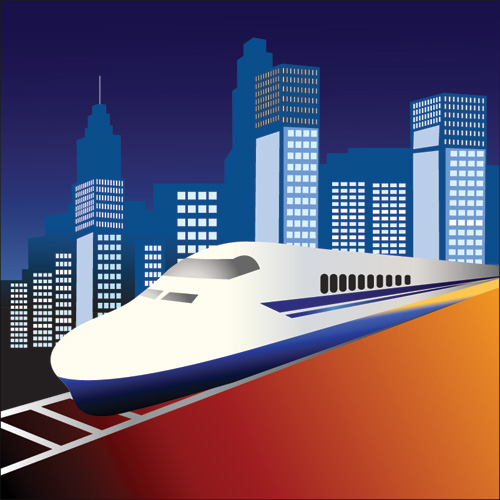 Twenty years after the Pacific Northwest was designated a high-speed rail corridor, Oregon begins planning a Eugene-to-Portland high-speed rail project.
Twenty years after the Pacific Northwest was designated a high-speed rail corridor, Oregon begins planning a Eugene-to-Portland high-speed rail project.
BY LINDA BAKER
 Twenty years ago, the Cascadia region from Eugene to Vancouver, B.C., was identified as one of 11 federally designated high-speed rail corridors. Since then, the Pacific Northwest corridor has received about $1.5 billion dollars in federal funding for rail improvements, which has resulted in additional Amtrak service between Seattle and Portland, improved schedule reliability, and reduced travel times.
Twenty years ago, the Cascadia region from Eugene to Vancouver, B.C., was identified as one of 11 federally designated high-speed rail corridors. Since then, the Pacific Northwest corridor has received about $1.5 billion dollars in federal funding for rail improvements, which has resulted in additional Amtrak service between Seattle and Portland, improved schedule reliability, and reduced travel times.
These improvements are nothing to sneeze at. But for commuters who think high-speed rail should be, well, high speed, the kind of 140 mile-per-hour plus system that would get business executives, tourists, students, et al, from Seattle to Portland in 60 minutes, the kind of transportation system that is springing up virtually everywhere in the developed and developing world — well, think again.
Because Oregon is on the very very slow train to building that kind of system.
In the past two weeks, a new stage in the incremental process has started to unfold. The Oregon Department of Transportation is conducting open houses (on site and online) through Jan. 25 to explore possible high speed or “higher speed” rail alignments on one segment of the NW Corridor: from Eugene to Portland, where Amtrak trains currently shuffle along at about 43 miles per hour. The goals include figuring out the preferred alternative for the alignment, where the stations will be located, and connectivity between the rail corridor and other modes of transportation.
ODOT received $4.2 million from the Federal Railroad Administration to conduct the study; the agency kicked in another $5.8 million and will submit its preference to the Federal Railroad Administration by the end of 2014, said Jyll Smith, an ODOT spokesperson. Only then will the project actually be in the running for future funding.
“This is step one of someday actually being able to have something,” Smith said.
For those who wonder why Oregon passenger trains and the high-speed rail process move so slowly, the answers run the gamut: freight companies control most passenger rail tracks, ODOT policy has historically skewed toward cars, not rail, and there exists a longstanding perception that high-speed rail is some kind of government boondoggle, a mass-transit bridge to nowhere.
But maybe it’s time for a new way of thinking. Over the next 25 years, the population of the Willamette Valley is expected to grow by approximately 35 percent, with the population anticipated to reach 3.6 million by the year 2035. During the same period, freight volume in the state is expected to grow by 60 percent. Roads may be part of the solution, but developing a high-speed rail corridor is as important economically as the Columbia River Crossing.
“It’s time we take a serious look at a system’s that’s used successfully around the world,” says Brad Perkins, a local realtor and president of Cascadia High Speed Rail, a nonprofit Perkins is considering changing to a for-profit to help accelerate the rail development process. On the Portland to Eugene corridor, Perkins favors an ambitious new track along I-5, a version of which ODOT is considering as one of four possible alignments. Perkins’ idea is to build that track in three phases, the first of which would connect the Rose Quarter to Vancouver, Wash. That project would revitalize local as well as regional economies, he says.
“We wouldn’t have to beg developers to build a hotel at the convention center, because there would be thousands of people coming to the area every day,” he says. “This would be such a economic boon to the area.”
A high-speed rail corridor along I-5 would also intersect with changing transportation preferences among young people, who could potentially live in Albany and commute easily to Portland, Perkins says. To alleviate the burden on taxpayers, says Perkins, policymakers should also consider public private partnerships, with different users of the tracks helping pay for the system.
In the past two years, Oregon policy makers have taken a decidedly pragmatic approach to funding public services: streamline those services to make them more efficient, and then fund those more efficient programs. That’s the underlying logic behind Oregon’s much lauded education and health-care reform programs. But so far, transportation planning, at least planning of hugely complex infrastructure projects, hasn’t been subject to the Oregon reformist’s logic — the botched CRC planning and design process is just one example.
A Eugene-Portland high speed rail corridor may be an opportunity to change all that. As long as everyone keeps their eyes on the prize. So far in the public comment process, “the frequency of the trains and the travel time came out in top three of what people want,” Smith says. In other words, the Oregon rail project should reflect the pace of technological change taking place in transportation systems around the world. The result should be trains and tracks that get Oregonians where they want to go, fast.
Linda Baker is managing editor of Oregon Business.


